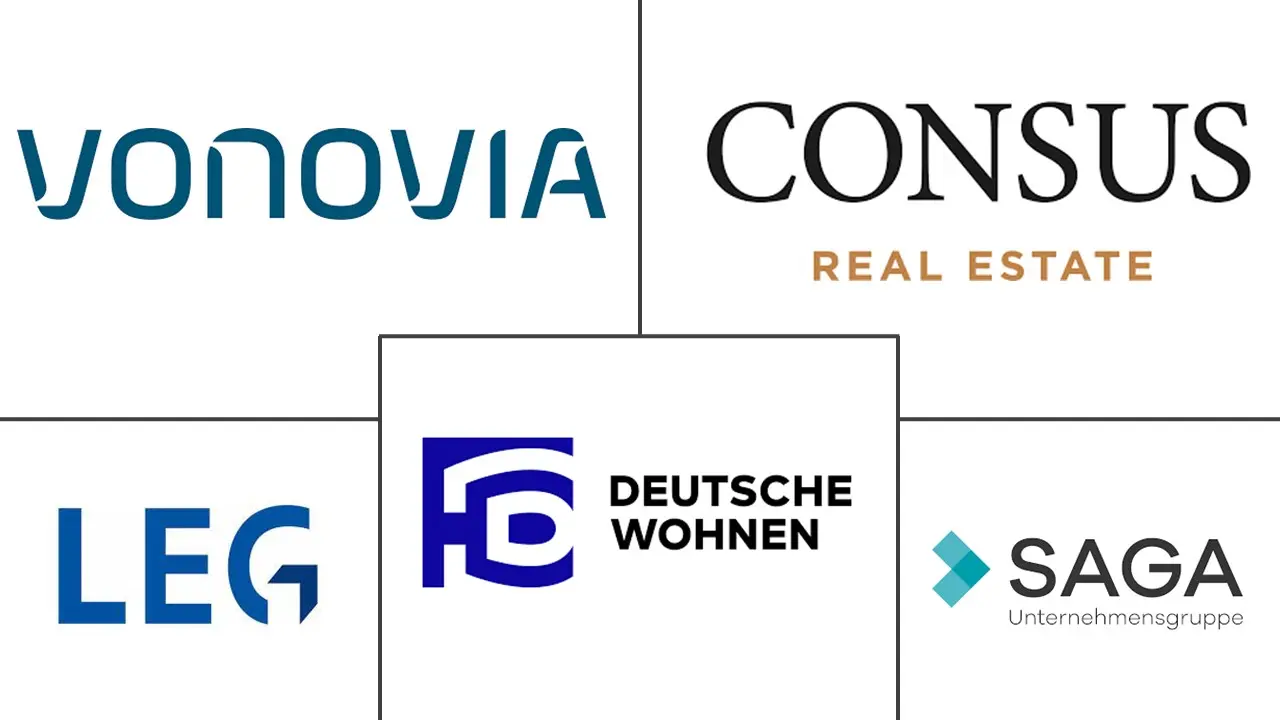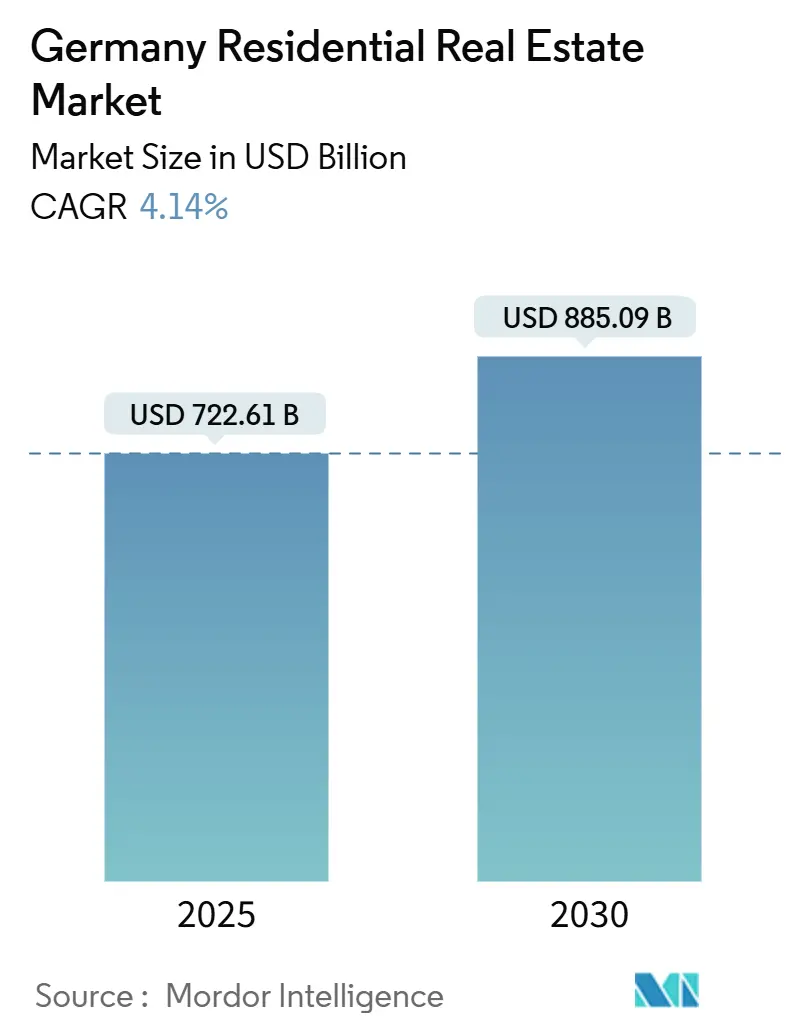
Germany Residential Real Estate Market Analysis by Mordor Intelligence
The German residential real estate market reached USD 722.61 billion in 2025 and is projected to expand to USD 885.09 billion by 2030, reflecting a 4.14% CAGR and confirming the sector’s steady rebound from the 2023–2024 downturn. Rising urban migration, persistent housing shortages and supportive green-building incentives continue to outweigh lingering construction-cost pressures, positioning the German real estate market for durable, policy-backed growth. Institutional capital inflows into build-to-rent schemes, senior-living facilities and energy-efficient developments reinforce overall resilience, while demographic diversity—especially international migration—keeps demand broad-based. Developer margins remain squeezed by cost inflation, yet KfW’s enlarged low-interest funding channels are cushioning balance sheets and accelerating ESG-compliant projects.
Key Report Takeaways
- By property type, apartments and condominiums led with 65.12% of Germany residential real estate market share in 2024; villas and landed houses are forecast to grow at a 4.31% CAGR to 2030.
- By price band, the mid-market segment commanded 47.12% of the Germany residential real estate market size in 2024, while affordable housing is advancing at a 4.34% CAGR through 2030.
- By business model, sales transactions held 66% of the Germany residential real estate market in 2024, whereas rental activity is set to expand at a 4.51% CAGR to 2030.
- By mode of sale, secondary-market deals accounted for 71% of the Germany residential real estate market in 2024, while primary-market transactions are projected to grow at a 4.55% CAGR by 2030.
- By geography, Berlin accounted for 14.8% of the Germany residential real estate market in 2024; Leipzig posts the fastest 4.6% CAGR forecast through 2030.
Germany Residential Real Estate Market Trends and Insights
Drivers Impact Analysis
| Driver | ( ~ ) % Impact on CAGR Forecast | Geographic Relevance | Impact Timeline |
|---|---|---|---|
| Rising urbanization and single-person households | +0.8% | Berlin, Munich, Hamburg | Medium term (2-4 years) |
| ESG regulation & KfW subsidies | +0.6% | Bavaria, Baden-Württemberg | Long term (≥ 4 years) |
| Influx of high-skill migrants | +0.5% | Berlin, Munich, Frankfurt | Short term (≤ 2 years) |
| Demographic aging | +0.4% | Rural eastern regions | Long term (≥ 4 years) |
| Build-to-Rent Institutional Investment Unlocking Mid-Range Supply | +0.3% | Major metropolitan areas, expanding to secondary cities | Medium term (2-4 years) |
| Adoption of Prefabrication Shortening Construction Cycles | +0.2% | National, with pilot projects in North Rhine-Westphalia | Medium term (2-4 years) |
| Source: Mordor Intelligence | |||
Rising Urbanization and Single-Person Households Driving Apartment Demand
Germany’s city populations continue to swell as single-person households touch new highs, pushing sustained demand for compact centrally located units. Berlin’s population edged up to 3.897 million in 2024, with 25,509 new foreign registrations adding immediate strain to already tight apartment inventories. Similar patterns in Munich and Hamburg drive developers toward high-density designs and modular construction that shorten build cycles. Southern tech hubs exhibit the steepest medium-term growth, whereas certain eastern rural districts experience population loss that reallocates construction focus. Micro-apartments and co-living schemes in Frankfurt and Berlin underscore emerging preferences for access over space, reinforcing the momentum behind the German real estate market.
ESG Regulation & KfW Subsidies Accelerating Energy-Efficient New Builds
Germany’s climate-neutral-by-2045 target is tightening building codes and making ESG compliance a prerequisite for financing. KfW now offers up to EUR 150,000 per unit in low-interest loans for certified climate-friendly projects, sharply lowering capital costs for compliant developers[1]KfW Bankengruppe, “KfW Förderreport Q1 2025,” kfw.de. Heating-system grants covering as much as 70% of installation expense further sweeten project economics and are steering many builders toward net-zero ready specifications. Large landlords such as Vonovia have earmarked EUR 2 billion for green modernization, betting that sustainable assets will secure superior occupancy and regulatory approval. Over time, green standards are expected to evolve from a premium feature to a baseline requirement in the German real estate market.
Demographic Aging Boosting Senior-Living Demand
Citizens aged 65+ are set to rise to 28% of Germany’s population by 2040, spurring demand for barrier-free housing and integrated care facilities, especially in the rural east[2]Bertelsmann Stiftung, “Demografiereport Deutschland 2040,” bertelsmann-stiftung.de. Institutional investors view senior living as counter-cyclical: Vonovia’s recent acquisition of multiple care properties underscores strategic confidence in this niche. Retrofit activity is also intensifying as owners adapt existing units for aging-in-place preferences. Service-oriented design—proximity to medical infrastructure, accessible layouts and community spaces—is expected to differentiate winning projects. This demographic tailwind gives the German real estate market another long-term defensive pillar.
Influx of High-Skill Migrants Raising Rental Housing Needs in Tech Hubs
Berlin’s foreign population climbed to 971,878 in 2024, equal to 24.9% of residents, buoyed by skilled professionals from India, China and beyond. Frankfurt and Munich are recording similar inflows linked to fintech and semiconductor expansions. These cohorts generally favor high-quality rentals near employment clusters, sustaining premium occupancy and rental growth. Developers tailoring units with flexible lease terms, furnished options and strong digital connectivity are capitalizing on this trend. The geographic concentration of talent keeps upward pressure on rents in core districts and cements rentals as the quickest-growing slice of the German real estate market.
Restraints Impact Analysis
| Restraint | ( ~ ) % Impact on CAGR Forecast | Geographic Relevance | Impact Timeline |
|---|---|---|---|
| Construction Cost Inflation Compressing Developer Margins | -1.2% | National, with acute impact in high-cost metropolitan areas | Long term (≥ 4 years) |
| Skilled-Labour Shortages Causing Project Delays | -0.6% | National, particularly acute in Bavaria, Baden-Württemberg | Medium term (2-4 years |
| Rising ECB Rates Tightening Mortgage Affordability | -0.5% | National, with higher impact on first-time buyers | Short term (≤ 2 years) |
| Urban rent caps | -0.4% | Berlin, Munich, Frankfurt, Hamburg | Short term (≤ 2 years) |
| Source: Mordor Intelligence | |||
Construction Cost Inflation Compressing Developer Margins
Construction prices rose 3.2% year-on-year in February 2025, extending a decade-long surge that has inflated costs by 64% since 2010[3]Statistisches Bundesamt, “Baupreise für Wohngebäude Februar 2025,” destatis.de. Higher steel, concrete and wage bills threaten project viability, especially in land-scarce metros where plots already command hefty premiums. Nearly half of contractors anticipate revenue declines in 2025, prompting greater adoption of prefabrication, longer supplier contracts and design simplification. The German real estate market therefore faces an immediate profitability squeeze until cost curves stabilize or innovations deliver material savings.
Urban Rent Caps Limiting Income Growth for Landlords
The federal extension of Mietpreisbremse through 2029 caps new leases at 10% above comparative local rent levels, curbing revenue upside for landlords in high-demand cities. Income ceilings risk discouraging fresh rental supply precisely where shortages are most acute. Owners are pivoting to ESG upgrades and new-build exemptions to preserve yields, yet chronic regulatory uncertainty remains a drag on investment momentum in core urban markets.
Segment Analysis
By Property Type: Apartments Drive Urban Density
Apartments and condominiums held 65.12% of German real estate market share in 2024, underscoring how demographic change and urban job clustering sustain compact-unit demand. Average Berlin rents climbed 10.6% in 2024, validating the pricing power of well-located apartments amid limited new supply. Villas and landed houses, while a smaller slice, are projected to post a 4.31% CAGR as hybrid work lets households trade commute times for larger suburban lots. Modular construction and offsite prefabrication shorten delivery timelines for multifamily projects, enabling faster turnover of capital in the German real estate market.
Growing institutional appetite for build-to-rent apartments supports ongoing capital formation, and strong absorption rates justify premium amenities such as co-working spaces and fitness centers. Suburban single-family growth is most notable around Hamburg and Cologne, where pro-family policies and improved rail links encourage outbound migration. However, even these edge developments stay tied to urban cores through transit, keeping them integral to the broader German real estate market.
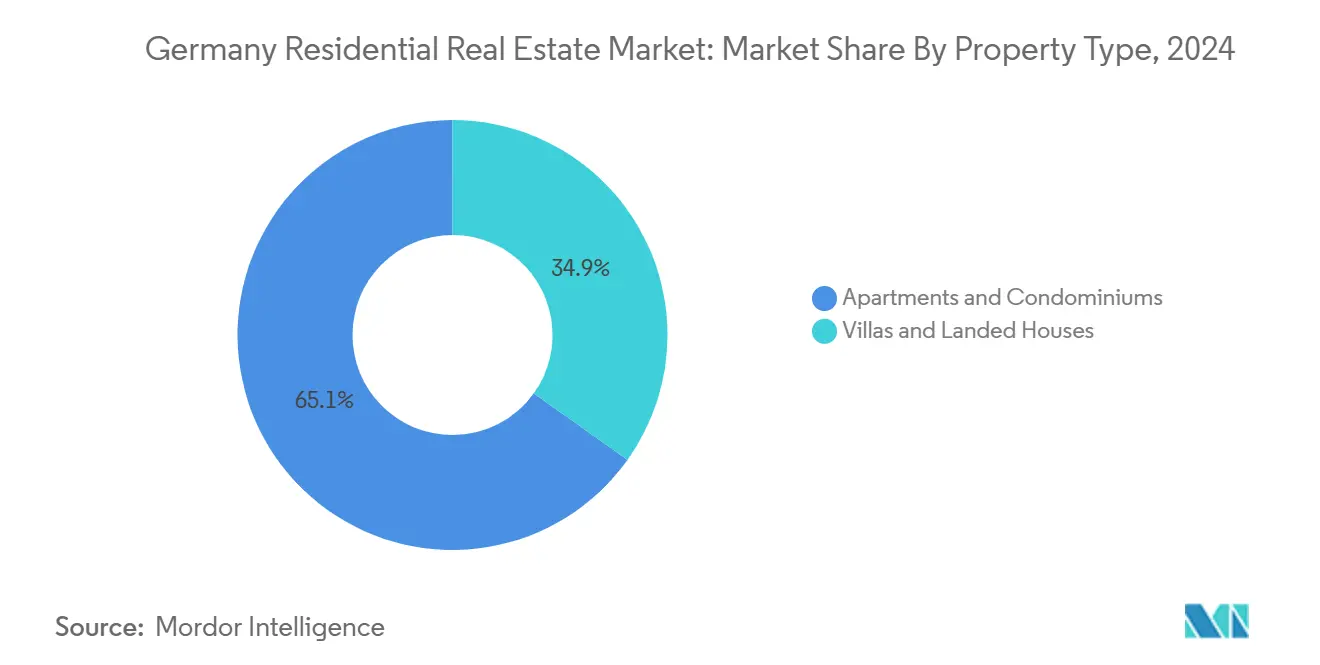
Note: Segment shares of all individual segments available upon report purchase
By Price Band: Affordable Housing Accelerates
Mid-market assets retained 47.12% of German real estate market size in 2024, yet the affordable tranche is the fastest-moving at 4.34% CAGR, helped by subsidies for 100,000 new social units every year and favorable depreciation rules. Developers able to balance cost controls with ESG targets stand to capture meaningful public funding and tax offsets. Although luxury homes trade on brand and scarcity, tightened mortgage affordability following ECB hikes has shifted volume toward subsidized products.
In eastern metros like Leipzig, natural affordability and rapid wage growth combine to draw value-seeking migrants, further boosting the affordable pipeline. Conversely, constrained prime-city plots leave the luxury segment more dependent on international buyers and cash-rich locals. Balanced portfolios that blend mid-market stability with subsidized affordable developments appear best positioned within the German real estate industry.
By Business Model: Rental Growth Outpaces Sales
Sales still represented 66% of 2024 turnover, yet rentals are charting a 4.51% CAGR through 2030 as younger households value flexibility over ownership. Institutional platforms now underwrite bulk rental schemes, viewing predictable cash flow as a hedge against price volatility. Vonovia invested EUR 409.6 million in upgrades during Q1 2025 to lift occupancy and extend asset life.
In Berlin and Munich, persistent inbound migration tightens vacancy below 2%, supporting rent premiums and incentivizing more supply under the rental format. Smaller cities remain sales-oriented, but a gradual cultural shift toward renting is visible nationwide, reinforcing rentals as a structural growth pillar of the German real estate market.
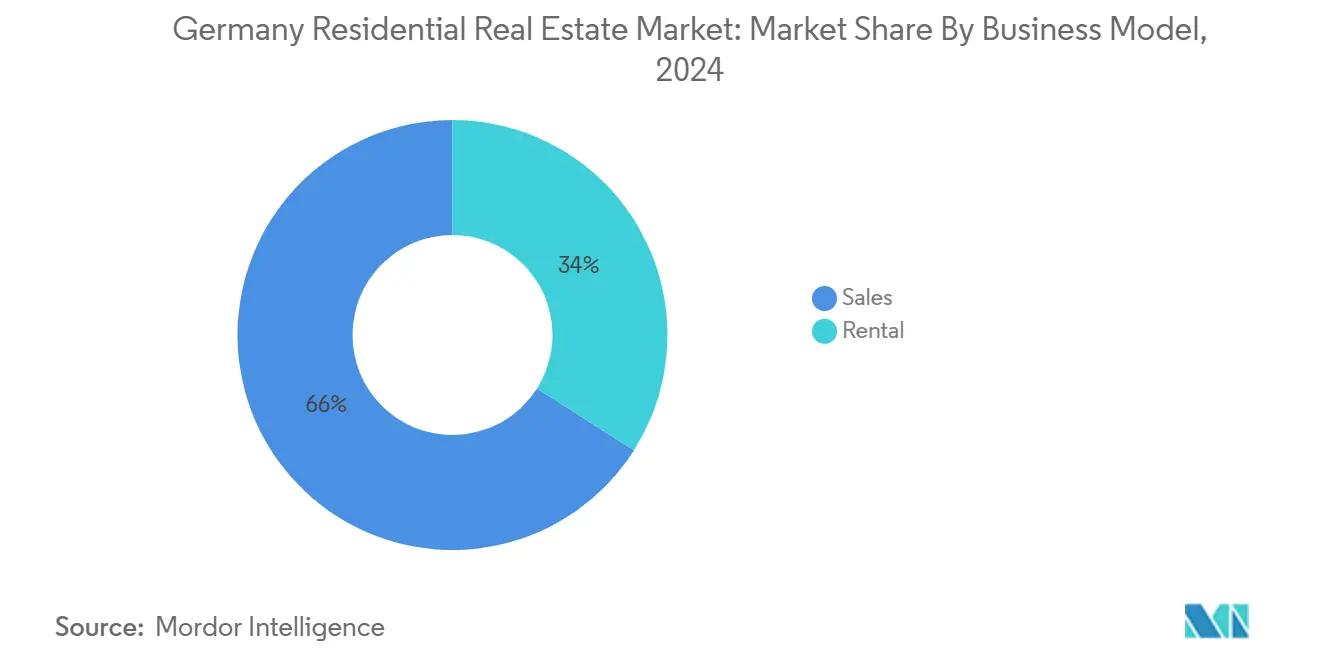
Note: Segment shares of all individual segments available upon report purchase
By Mode of Sale: Primary Market Gains Momentum
Secondary transactions comprised 71% of 2024 activity, reflecting Germany’s vast existing stock. Primary sales, however, are trending at a 4.55% CAGR as households seek energy-efficient new builds qualifying for KfW incentives. Buyers perceive future regulatory tightening and opt for compliant properties upfront, sidestepping retrofit expenses.
Housing-turbo reforms announced in February 2025 promise quicker approvals, which could lift new-build volume further. Growth corridors around Berlin’s outer ring and Munich’s periphery have become hotbeds for master-planned communities offering smart-home features, EV charging and heat-pump systems. This shift is expanding the total German real estate market size attributable to brand-new inventory.
Geography Analysis
Berlin commanded 14.8% of the German real estate market in 2024 and remains the nation’s most liquid housing hub. Average rents reached EUR 13.89 per sq m following a 10.6% annual rise, and limited developable land continues to support upward pressure despite rent-cap policies. Government social-housing pilots using modular units aim to ease shortages without diluting ESG goals, ensuring that new stock aligns with climate policy.
Leipzig offers the fastest expansion at a projected 4.6% CAGR to 2030. Its appeal lies in competitive pricing, good rail links and a strengthening logistics base that attracts both tenants and employers. Net-in-migration from Hamburg and Munich underscores its catch-up potential. Munich itself remains Germany’s most expensive city, with apartment prices topping EUR 7,273 per sq m, anchored by a robust life-science and semiconductor cluster that cushions against macro shocks.
Frankfurt benefits from post-Brexit financial relocations and sustained demand for premium downtown rentals, as 6% of 2024 home sales involved foreign buyers. Hamburg’s port-anchored economy gives stable, if slower, housing growth. Cologne and Düsseldorf stand out as balanced markets combining relative affordability with strong employment fundamentals. Ongoing infrastructure upgrades across the Rhine-Ruhr area further solidify Germany’s polycentric structure, allowing investors and developers to diversify while staying within the German real estate market.
Competitive Landscape
The sector exhibits moderate concentration, headlined by Vonovia SE with roughly 543,000 units worth EUR 83.7 billion across three countries. After booking EUR 6.8 billion in 2023 losses, Vonovia improved Q1 2025 adjusted EBITDA by 15.1%, highlighting operational efficiencies and a pivot toward high-yield renovations[4]Vonovia SE, “Quarterly Statement Q1 2025,” vonovia.de. ESG alignment sits at the center of competitive strategy; leading landlords race to retrofit stocks to meet 2045 climate-neutral goals, reducing energy intensity and attracting subsidized financing.
Consolidation continues via selective acquisitions—Vonovia’s earlier takeover of Deutsche Wohnen remains the template—while capital-rich foreign funds pursue platform buys such as Partners Group’s pending Empira deal. Tech adoption is diverging: larger players employ BIM, IoT sensors and AI-driven maintenance scheduling, unlocking cost and tenant-service advantages. Smaller regional owners retain edge through hyper-local market knowledge but face higher compliance and capital costs.
Senior-living, affordable-housing and build-to-rent verticals are drawing specialized entrants backed by pension and insurance capital seeking reliable long-duration income. This specialization heightens overall capability demands within the German real estate market and places a premium on execution expertise and scalability.
Germany Residential Real Estate Industry Leaders
-
Vonovia SE
-
Deutsche Wohnen SE
-
LEG Immobilien SE
-
Consus Real Estate
-
SAGA Unternehmensgruppe Hamburg
- *Disclaimer: Major Players sorted in no particular order
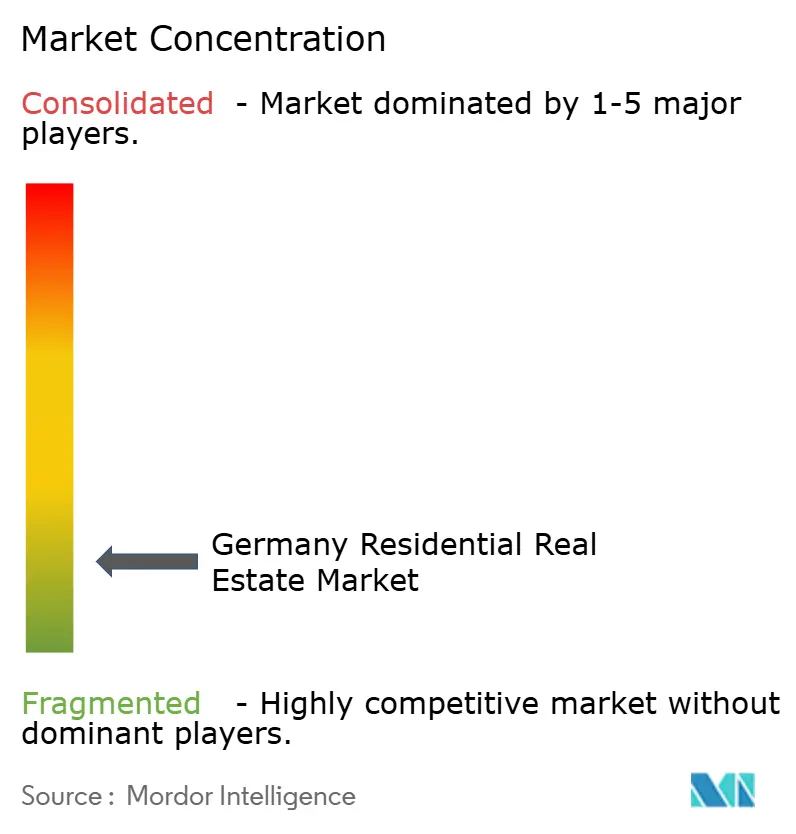
Recent Industry Developments
- May 2025: Vonovia SE reported a 15.1% Q1 2025 adjusted EBITDA increase to EUR 698.5 million and named Luka Mucic as incoming CEO.
- April 2025: Postbank’s Wohnatlas 2025 projected 0.4% annual price rises for existing condos nationwide to 2035, with Leipzig at 1.9%.
- March 2025: Vonovia closed 2024 at EUR 2.6 billion adjusted EBITDA and outlined 3,000 new units for 2025.
- February 2025: Federal “housing construction turbo” package pledged faster permits and higher social-housing spend.
Research Methodology Framework and Report Scope
Market Definitions and Key Coverage
Our study defines the German residential real estate market as the aggregated monetary value of land and permanently constructed dwellings intended for private habitation, across single-family, multi-family, and mixed-use buildings that hold a majority residential share. According to Mordor Intelligence, rental flows and owner-occupied housing stock are covered alongside new-build and resale transactions to present a full-economy view.
Scope exclusion: temporary lodging such as serviced apartments or student dormitories is not quantified here.
Segmentation Overview
- By Property Type
- Apartments & Condominiums
- Villas & Landed Houses
- By Price Band
- Affordable
- Mid-Market
- Luxury
- By Business Model
- Sales
- Rental
- By Mode of Sale
- Primary (New-Build)
- Secondary (Existing Home Resale)
- By Key Cities
- Berlin
- Hamburg
- Munich
- Cologne
- Frankfurt
- Dusseldorf
- Leipzig
- Rest of Germany
Detailed Research Methodology and Data Validation
Primary Research
Telephone interviews and online surveys with residential brokers, planning officers, institutional landlords, and prop-tech lenders across Berlin, Munich, Frankfurt, and secondary cities helped us validate absorption rates, typical price per square meter, and rental escalation assumptions, ensuring regional nuances funnel into the national model.
Desk Research
Mordor analysts began with federal datasets such as Destatis dwelling completions, BaFin mortgage volumes, and Bundesbank property price indices, which were then cross-read with Eurostat urbanization statistics and German Construction Federation permit logs. We enriched gaps through trade bodies like the German Property Federation (ZIA) and peer-reviewed journals on housing affordability. Paid resources, notably D&B Hoovers for developer financials and Dow Jones Factiva for capital-market activity, supplied firm-level metrics that public sources missed. This list is illustrative; many further publications, filings, and customs extracts informed the desk phase.
Market-Sizing & Forecasting
A top-down model converts dwelling stock and average market price into a 2025 baseline, while selective bottom-up checks of developer revenues and sampled average selling price times units keep totals grounded. Key drivers include building permits issued, completion delays, median mortgage rates, net migration, vacancy levels, and the Mietspiegel rental index, which together explain demand and price tension. Forecasts employ multivariate regression with scenario overlays, letting us stress test interest-rate or immigration shocks before producing the 2030 outlook.
Data Validation & Update Cycle
Outputs pass multi-source checks, variance flags, and senior analyst review. Reports refresh yearly, with interim updates triggered by policy shifts or macro surprises, so clients receive numbers that remain current.
Why Mordor's Residential Real Estate Market In Germany Size & Share Analysis Baseline Commands Reliability
Published estimates often diverge because firms choose different asset scopes, price proxies, and refresh rhythms.
Key gap drivers include whether stock or transaction value is measured, how resale housing is treated, and if rental income streams are capitalized. Mordor selects a balanced scope, applies transparent variable layering, and updates annually, which keeps our baseline dependable for investors and policymakers.
Benchmark comparison
| Market Size | Anonymized source | Primary gap driver |
|---|---|---|
| USD 722.61 B (2025) | Mordor Intelligence | - |
| EUR 29.6 T (2024) | Global Consultancy A | Captures total asset stock, minimal macro driver layering |
| USD 12.6 B (2024) | Industry Analyst B | Focuses new-build transactions only, excludes existing stock and rentals |
The comparison shows that, by selecting the right scope and grounding forecasts in verified housing, financing, and demographic variables, Mordor Intelligence delivers a balanced, transparent baseline that decision-makers can retrace and replicate.
Key Questions Answered in the Report
What is the current value of the German real estate market?
It stands at USD 722.61 billion in 2025 and is forecast to reach USD 885.09 billion by 2030.
Which city holds the largest share of the German real estate market?
Berlin leads with 14.8% of national housing value in 2024.
Why are rentals growing faster than sales in Germany?
Mobility preferences, institutional build-to-rent investment and tighter mortgage affordability are accelerating rental demand at a 4.51% CAGR.
How do KfW subsidies influence new construction?
Low-interest loans of up to EUR 150,000 per unit and heating-system grants covering up to 70% of costs make energy-efficient new builds financially attractive.
Page last updated on:
